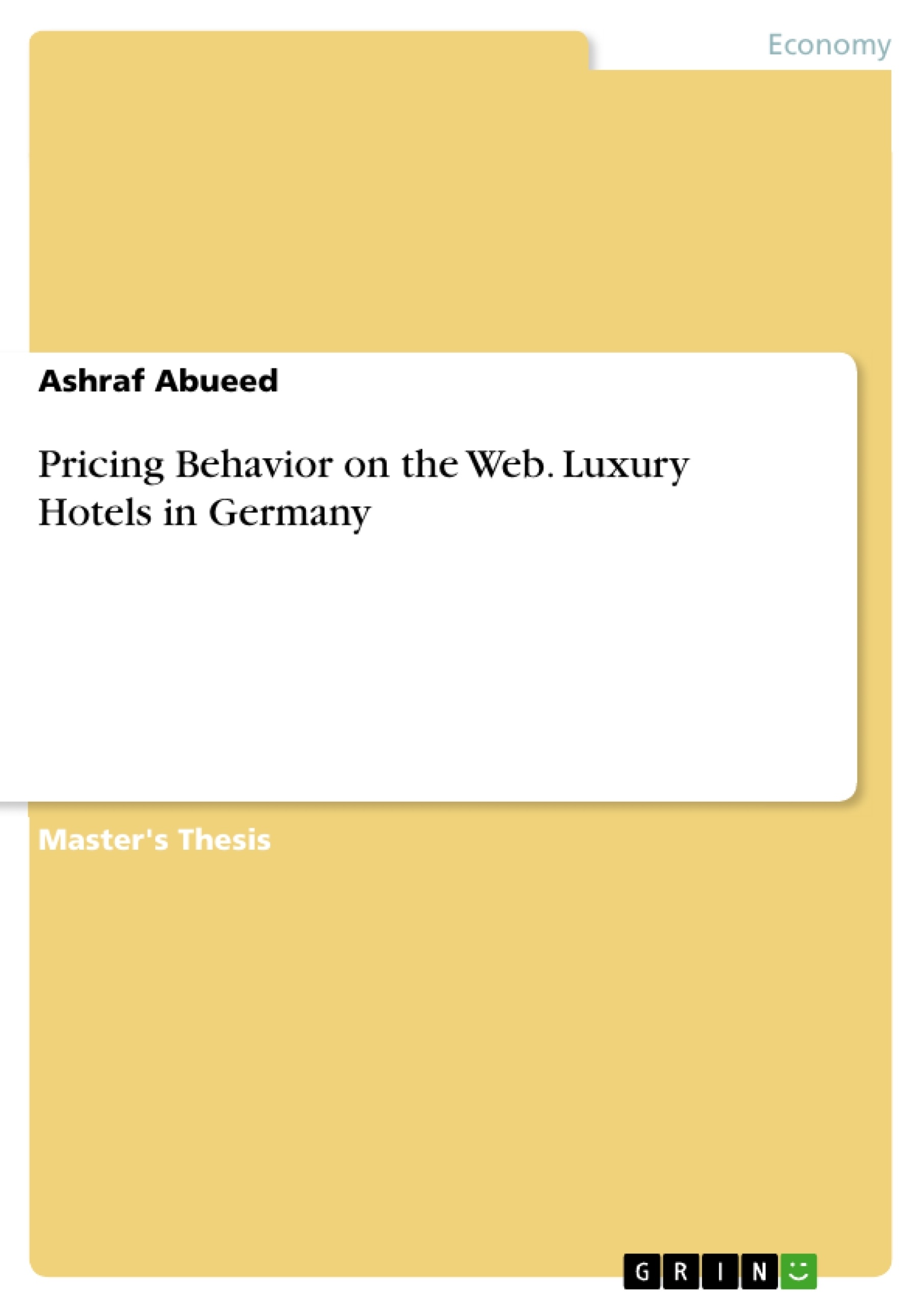The prominence of the web as a distribution channel for hotel rooms as well as its transparency and ease for price comparison create a need for the hoteliers to think strategically in terms of rate setting and pricing practices on numerous web-based distribution channels. The overarching purpose of this exploratory study is to inves-tigate the current online pricing practices of luxury hotels in Germany and to explore potential challenges that they face in distributing their rooms on the web. The data covering 29 hotels in the top 4 primary cities in Germany was collected from 11 B2C, web-based distribution channels over a 26-day period at 6 separate points in time leading up to predetermined arrival date. These channels, including the hotels' own websites along with 10 indirect channels, represent various types of operation. The data were analyzed by means of descriptive statistics. Personal interviews with the regional director of revenue management and the regional web & e-commerce executive of an international hotel company were conducted to support the findings and to gain supplemental insights into the relevant issues. Key findings of this study were that a complete rate consistency did not exist across the utilized channels, and that a customer who surfs the web for a particular hotel may find better rates and conditions than those offered by the hotels' own websites, which negates the best-rate guarantee that is claimed by many hotels. The reselling of net rates to the end-customer on the web was identified as a crucial challenge faced by the hoteliers, which leads to the loss of a hotel's control over pricing. Furthermore, the findings suggest that in many instances, the hoteliers neither applied logical pricing practices nor ensured an adequate presence on the web. Logical pricing practices aim to optimize revenue, while ensuring customer satisfaction. This paper is meant to be a starting point for hoteliers who are interesting in better understanding the power of online pricing and its impact on hotel profitability, and to reevaluate their prices and presence across the various web-based distribution channels. Shifting away from complex revenue management systems, this study outlines some recommendations that could be useful for hoteliers in their effort to maximize their revenues and profit, while keeping the focus on the customer as a focal point.
Inhaltsverzeichnis (Table of Contents)
- Abstract
- Kurzfassung
- Table of Contents
- List of Figures
- List of Tables
- List of Abbreviations
- Preface
- 1. INTRODUCTION AND INITIAL SITUATION
- 1.1 Research Motivation and Problem Depiction
- 1.2 Significance of the Research and Background of the Research Problem
- 1.3 Study Objectives and Research Questions
- 1.4 Outline of the Thesis
- 2. THEORETICAL AND EMPIRICAL BACKGROUND
- 2.1 Special Characteristics of Hotel Marketing
- 2.2 Distribution Channels of Hotel Rooms
- 2.2.1 Historical Perspective on Electronic Hotel Distribution
- 2.2.2 The Arrival of the Web Commerce
- 2.2.3 Hotel Rooms Distribution on the Web (IDS)
- 2.2.4 Typology of the Internet Distribution System
- 2.2.4.1 Proprietary website
- 2.2.4.2 Branded hotel company CRS website
- 2.2.4.3 Soft hotel brand websites
- 2.2.4.4 Third‐party Internet sites
- 2.2.5 Channels Connectivity and Data Exchange
- 2.2.6 Cost of Distribution on the Web
- 2.3 Pricing of Hotel Rooms
- 2.3.1 Fundamentals of Pricing and Its Levels of Implementation
- 2.3.1.1 Fundamental Approaches to Pricing
- 2.3.1.2 Levels of the Pricing Implementation
- 2.3.2 The Financial Power of Pricing
- 2.3.3 Pricing tactics and Practices
- 2.3.3.1 Differential Room Pricing and Rate Fencing
- 2.3.3.2 Variable Pricing
- 2.3.4 Controversial Concepts in the World of Hotel‐Room Pricing
- 2.3.4.1 Rate Parity
- 2.3.4.2 Rate Integrity
- 2.3.4.3 Best‐Rate Guarantee
- 2.4 Revenue Management
- The study aims to examine the current online pricing practices of luxury hotels in Germany.
- The current research seeks to explore any potential weaknesses or challenges that luxury hoteliers in Germany could face when using any one of several web‐based distribution channels.
- The study forms an accurate picture of the existing trend by providing some evidence on the current behavior of hotel operators in the luxury hotel sector in Germany.
- The study suggests practical implications and professional recommendations for luxury hotel operators in Germany.
- The study investigates whether room rates are being set consistently across the utilized web‐based distribution channels.
- Chapter 1 presents an overview of the research problem and its significance for the German luxury hotel market. It also outlines the study's objectives and research questions.
- Chapter 2 provides a comprehensive overview of the theoretical and empirical literature on the topics of hotel distribution, pricing, and revenue management. It also discusses key concepts such as rate parity, rate integrity, and best‐rate guarantee.
- Chapter 3 describes the methodology used for data collection and analysis. The study utilizes a mixed‐methods approach, combining quantitative data from online observations with qualitative data from interviews with hotel revenue management professionals.
- Chapter 4 presents the findings of the research and discusses their implications for the German luxury hotel market.
Zielsetzung und Themenschwerpunkte (Objectives and Key Themes)
The purpose of this exploratory study is to investigate the current online pricing practices of luxury hotels in Germany and to explore potential challenges that they face in distributing their rooms on the web.
Zusammenfassung der Kapitel (Chapter Summaries)
Schlüsselwörter (Keywords)
The key focus topics of this text are online room pricing, web commerce, Internet Distribution System, luxury city hotels in Germany, revenue management, rate parity, and rate integrity.
- Quote paper
- Ashraf Abueed (Author), 2014, Pricing Behavior on the Web. Luxury Hotels in Germany, Munich, GRIN Verlag, https://www.grin.com/document/309691



